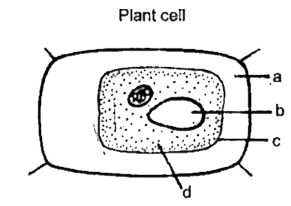What would happen if a plasmolysed cell is kept in pure water?
Step-by-Step Solution:
1. Understanding Plasmolysis:
- Plasmolysis is the process where a cell loses water and the cytoplasm shrinks away from the cell wall. This occurs when a cell is placed in a hypertonic solution, causing water to exit the cell.
2. Condition of the Plasmolysed Cell:
- In a plasmolyzed cell, the protoplasm is shrunken and has a reduced volume due to the loss of water.
3. Introducing Pure Water:
- When a plasmolyzed cell is placed in pure water, it is exposed to a hypotonic environment (pure water has a higher concentration of water molecules compared to the cell's interior).
4. Osmosis Process:
- Osmosis is the movement of water molecules from an area of higher concentration (in this case, pure water) to an area of lower concentration (inside the plasmolyzed cell). This movement occurs through a semi-permeable membrane.
5. Water Movement into the Cell:
- Water from the pure water outside will flow into the cell because the cell has a lower concentration of water (due to the plasmolysis).
6. Resulting Effect - Deplasmolysis:
- As water enters the cell, the protoplasm will begin to swell and expand back towards its original state. This process is known as deplasmolysis, which is the opposite of plasmolysis.
7. Conclusion:
- Therefore, if a plasmolyzed cell is kept in pure water, it will undergo deplasmolysis, resulting in the protoplasm swelling back to its normal state.
- Plasmolysis is the process where a cell loses water and the cytoplasm shrinks away from the cell wall. This occurs when a cell is placed in a hypertonic solution, causing water to exit the cell.
- In a plasmolyzed cell, the protoplasm is shrunken and has a reduced volume due to the loss of water.
- When a plasmolyzed cell is placed in pure water, it is exposed to a hypotonic environment (pure water has a higher concentration of water molecules compared to the cell's interior).
- Osmosis is the movement of water molecules from an area of higher concentration (in this case, pure water) to an area of lower concentration (inside the plasmolyzed cell). This movement occurs through a semi-permeable membrane.
- Water from the pure water outside will flow into the cell because the cell has a lower concentration of water (due to the plasmolysis).
- As water enters the cell, the protoplasm will begin to swell and expand back towards its original state. This process is known as deplasmolysis, which is the opposite of plasmolysis.
- Therefore, if a plasmolyzed cell is kept in pure water, it will undergo deplasmolysis, resulting in the protoplasm swelling back to its normal state.
Topper's Solved these Questions
- BOOK - ICSECHAPTER - TRANSPORT IN PLANTS EXERCISE - TEST YOUR PROGRESS (SHORT/LONG ANSWER TYPE QUESTIONS)34videos
TRANSPORT IN PLANTS
- BOOK - ICSECHAPTER - TRANSPORT IN PLANTS EXERCISE - TEST YOUR PROGRESS (HIGHER ORDER THINKING SKILLS QUESTIONS (HOTS))9videos
TRANSPORT IN PLANTS
- BOOK - ICSECHAPTER - TRANSPORT IN PLANTS EXERCISE - TEST YOUR PROGRESS (State whether the following statements are true or false)16videos
TRANSPORT IN PLANTS
- BOOK - ICSECHAPTER - THE LIVING WORLD EXERCISE - Ncert Exercises (Differentiate Between )4videos
THE LIVING WORLD
Similar Questions
Knowledge Check
- Question 1 - Select One
For a plasmolysed cell, which equation is correct ?
ADPD = OP + TPBDPD = - TPCDPD = OPDDPD = OP - TP - Question 2 - Select One
When a plant cell is placed in pure water, it will
Abecome rigid because of turgor pressureBlose water and wiltCswell and burstDalter its cell wall composition so that it becomes impermeable to water
Pressure potential in a plasmolysed cell is
View SolutionExplain what would happen if:
A plant is kept near an open windowView SolutionStudy the diagram given alongside showing a plant cell kept in a strong sugar solution.

What will happen to this cell if it is kept in water?View SolutionWhen a cell is plasmolysed
View SolutionWhat would happen if a plasmid without a selectable marker was chosen as a cloning vector?
View SolutionWhat do you think would happen if a plant cell did not have a cell wall?
View Solution

